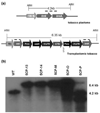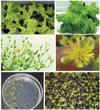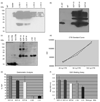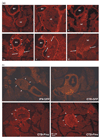Expression of cholera toxin B-proinsulin fusion protein in lettuce and tobacco chloroplasts--oral administration protects against development of insulitis in non-obese diabetic mice
- PMID: 17490448
- PMCID: PMC2590789
- DOI: 10.1111/j.1467-7652.2007.00259.x
Expression of cholera toxin B-proinsulin fusion protein in lettuce and tobacco chloroplasts--oral administration protects against development of insulitis in non-obese diabetic mice
Abstract
Lettuce and tobacco chloroplast transgenic lines expressing the cholera toxin B subunit-human proinsulin (CTB-Pins) fusion protein were generated. CTB-Pins accumulated up to ~16% of total soluble protein (TSP) in tobacco and up to ~2.5% of TSP in lettuce. Eight milligrams of powdered tobacco leaf material expressing CTB-Pins or, as negative controls, CTB-green fluorescent protein (CTB-GFP) or interferon-GFP (IFN-GFP), or untransformed leaf, were administered orally, each week for 7 weeks, to 5-week-old female non-obese diabetic (NOD) mice. The pancreas of CTB-Pins-treated mice showed decreased infiltration of cells characteristic of lymphocytes (insulitis); insulin-producing beta-cells in the pancreatic islets of CTB-Pins-treated mice were significantly preserved, with lower blood or urine glucose levels, by contrast with the few beta-cells remaining in the pancreatic islets of the negative controls. Increased expression of immunosuppressive cytokines, such as interleukin-4 and interleukin-10 (IL-4 and IL-10), was observed in the pancreas of CTB-Pins-treated NOD mice. Serum levels of immunoglobulin G1 (IgG1), but not IgG2a, were elevated in CTB-Pins-treated mice. Taken together, T-helper 2 (Th2) lymphocyte-mediated oral tolerance is a likely mechanism for the prevention of pancreatic insulitis and the preservation of insulin-producing beta-cells. This is the first report of expression of a therapeutic protein in transgenic chloroplasts of an edible crop. Transplastomic lettuce plants expressing CTB-Pins grew normally and transgenes were maternally inherited in T(1) progeny. This opens up the possibility for the low-cost production and delivery of human therapeutic proteins, and a strategy for the treatment of various other autoimmune diseases.
Figures








Similar articles
-
Chloroplast-derived vaccine antigens confer dual immunity against cholera and malaria by oral or injectable delivery.Plant Biotechnol J. 2010 Feb;8(2):223-42. doi: 10.1111/j.1467-7652.2009.00479.x. Epub 2009 Dec 28. Plant Biotechnol J. 2010. PMID: 20051036 Free PMC article.
-
Low-cost production of proinsulin in tobacco and lettuce chloroplasts for injectable or oral delivery of functional insulin and C-peptide.Plant Biotechnol J. 2011 Jun;9(5):585-98. doi: 10.1111/j.1467-7652.2010.00582.x. Epub 2010 Dec 8. Plant Biotechnol J. 2011. PMID: 21143365 Free PMC article.
-
Low cost tuberculosis vaccine antigens in capsules: expression in chloroplasts, bio-encapsulation, stability and functional evaluation in vitro.PLoS One. 2013;8(1):e54708. doi: 10.1371/journal.pone.0054708. Epub 2013 Jan 23. PLoS One. 2013. PMID: 23355891 Free PMC article.
-
Mucosally induced immunological tolerance, regulatory T cells and the adjuvant effect by cholera toxin B subunit.Scand J Immunol. 2010 Jan;71(1):1-11. doi: 10.1111/j.1365-3083.2009.02321.x. Scand J Immunol. 2010. PMID: 20017804 Review.
-
Chloroplast-derived vaccine antigens and biopharmaceuticals: expression, folding, assembly and functionality.Curr Top Microbiol Immunol. 2009;332:33-54. doi: 10.1007/978-3-540-70868-1_3. Curr Top Microbiol Immunol. 2009. PMID: 19401820 Free PMC article. Review.
Cited by
-
How can plant genetic engineering contribute to cost-effective fish vaccine development for promoting sustainable aquaculture?Plant Mol Biol. 2013 Sep;83(1-2):33-40. doi: 10.1007/s11103-013-0081-9. Epub 2013 Jun 1. Plant Mol Biol. 2013. PMID: 23729352 Free PMC article. Review.
-
The vaccine adjuvant extra domain A from fibronectin retains its proinflammatory properties when expressed in tobacco chloroplasts.Planta. 2010 Mar;231(4):977-90. doi: 10.1007/s00425-010-1102-4. Epub 2010 Jan 28. Planta. 2010. PMID: 20108000
-
Oral delivery of ACE2/Ang-(1-7) bioencapsulated in plant cells protects against experimental uveitis and autoimmune uveoretinitis.Mol Ther. 2014 Dec;22(12):2069-2082. doi: 10.1038/mt.2014.179. Epub 2014 Sep 17. Mol Ther. 2014. PMID: 25228068 Free PMC article.
-
Assessment of Carrot Callus as Biofactories of an Atherosclerosis Oral Vaccine Prototype.Mol Biotechnol. 2017 Dec;59(11-12):482-489. doi: 10.1007/s12033-017-0036-5. Mol Biotechnol. 2017. PMID: 28965203
-
Two decades of plant-based candidate vaccines: a review of the chimeric protein approaches.Plant Cell Rep. 2011 Aug;30(8):1367-82. doi: 10.1007/s00299-011-1065-3. Epub 2011 Apr 20. Plant Cell Rep. 2011. PMID: 21505834 Review.
References
-
- Arakawa T, Yu J, Chong D, Hough J, Engen P, Langridge W. A plant-based cholera toxin B subunit-insulin fusion protein protects against the development of autoimmune diabetes. Nature. 1998;16:934–938. - PubMed
-
- Birch-Machin I, Newell CA, Hibberd JM, Gray JC. Accumulation of rotavirus VP6 protein in chloroplasts of transplastomic tobacco is limited by protein stability. Plant Biotechnol J. 2004;2:261–270. - PubMed
-
- Burkart V, Kim Y, Kauer M, Kolb H. Induction of tolerance in macrophages by cholera toxin B chain. Pathobiology. 1999;67:314–317. - PubMed
Publication types
MeSH terms
Substances
Grants and funding
LinkOut - more resources
Full Text Sources
Other Literature Sources
Medical
Miscellaneous

